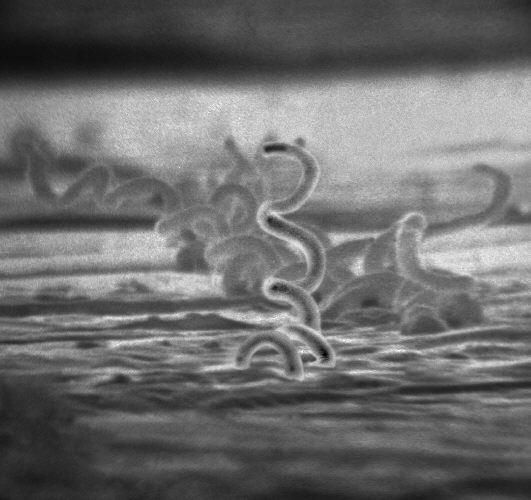Phylum Spirochaetes Higher classification Treponema | Genus Treponema Family Spirochaetaceae Rank Species Order Spirochaetes | |
 | ||
Similar Bacteria, Spirochaetes, Neisseria, Haemophilus | ||
Treponema pallidum bacteria
Treponema pallidum is a spirochaete bacterium with subspecies that cause treponemal diseases such as syphilis, bejel, pinta, and yaws. The treponemes have a cytoplasmic and an outer membrane. Using light microscopy, treponemes are visible only by using dark field illumination. They are Gram negative, but some regard them as too thin to be Gram stained.
Contents
- Treponema pallidum bacteria
- Espiroquetas quiz s spirochaeta spirochetes perhaps spirochaeta
- Subspecies
- Laboratory identification
- Clinical significance
- Genome
- Vaccine
- References
Espiroquetas quiz s spirochaeta spirochetes perhaps spirochaeta
Subspecies
At least four subspecies are known:
Some variation occurs as to which are considered subspecies, and which are species. The cause of pinta is sometimes described as Treponema carateum, rather than a subspecies of T. pallidum, even when the subspecies convention is used for the other agents.
Laboratory identification
This bacterium can be detected with special stains, such as the Dieterle stain. T. pallidum is also detected by serology, including nontreponemal VDRL, rapid plasma reagin, and treponemal antibody tests (FTA-ABS), T. pallidum immobilization reaction, and syphilis TPHA test). It was first microscopically identified in syphilitic chancres by Fritz Schaudinn and Erich Hoffmann at the Charité in Berlin in 1905
Clinical significance
T. p. pallidum is a motile spirochaete that is generally acquired by close sexual contact, entering the host via breaches in squamous or columnar epithelium. The organism can also be transmitted to a fetus by transplacental passage during the later stages of pregnancy, giving rise to congenital syphilis. The helical structure of T. p. pallidum allows it to move in a corkscrew motion through mucous membranes or enter minuscule breaks in the skin. In women the initial lesion is usually on the labia, the walls of the vagina, or the cervix; in men it is on the shaft or glans of the penis. It gains access to the host's blood and lymph systems through tissue and mucous membranes.
The subspecies causing yaws, pinta, and bejel are morphologically and serologically indistinguishable from T. p. pallidum (syphilis); however, their transmission is not venereal in nature and the course of each disease is significantly different.
Genome
The genome of T. pallidum was sequenced in 1998. The recent sequencing of the genomes of several spirochetes permits a thorough analysis of the similarities and differences within this bacterial phylum. T. p. pallidum has one of the smallest bacterial genomes at 1.14 million base pairs, and has limited metabolic capabilities, reflecting its adaptation through genome reduction to the rich environment of mammalian tissue. The shape of T. pallidum is flat and wavy, unlike the other spirochetes, which are helical.
Vaccine
No vaccine for syphilis is available as of 2015. The outer membrane of T. pallidum has too few surface proteins for an antibody to be effective. Efforts to develop a safe and effective syphilis vaccine have been hindered by uncertainty about the relative importance of humoral and cellular mechanisms to protective immunity, and because T. pallidum outer membrane proteins have not been unambiguously identified.
